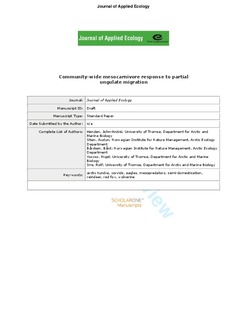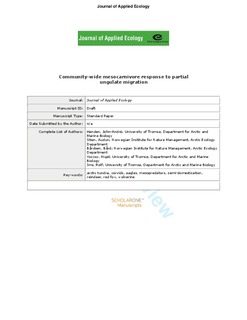| dc.contributor.author | Henden, John-André | |
| dc.contributor.author | Stien, Audun | |
| dc.contributor.author | Bårdsen, Bård-Jørgen | |
| dc.contributor.author | Yoccoz, Nigel Gilles | |
| dc.contributor.author | Ims, Rolf Anker | |
| dc.date.accessioned | 2015-02-23T14:28:21Z | |
| dc.date.accessioned | 2017-08-04T07:24:29Z | |
| dc.date.available | 2015-02-23T14:28:21Z | |
| dc.date.available | 2017-08-04T07:24:29Z | |
| dc.date.issued | 2014 | |
| dc.identifier.citation | Journal of Applied Ecology 2014, 51:1525-1533 | nb_NO |
| dc.identifier.issn | 1365-2664 | |
| dc.identifier.uri | http://hdl.handle.net/11250/2449874 | |
| dc.description.abstract | 1. Mesocarnivores increase in number and geographic range in human-disturbed ecosystems
with cascading negative impact on biodiversity. To mitigate such impacts, it is essential to
identify the proximate causes of such mesocarnivore releases. Here, we assess to what extent
increased partial migration in semi-domesticated tundra reindeer induce a response in boreal
and arctic mesocarnivores.
2. We used a large-scale and multiyear quasi-experimental study design with camera traps
deployed on coastal tundra peninsulas in northern Norway to estimate area occupancy of the
whole carnivore community. These peninsulas represent summer pastures for separate semidomestic
reindeer herds that, owing to different degrees of partial migration, now display spatially
and temporally variable densities of year-round resident reindeer. We estimated resident
reindeer density by means of aerial surveys.
3. Area occupancy of all the recorded carnivore species increased strongly when resident
reindeer densities exceeded 1 5 deer km
2.
4. Most of the increasing carnivore species were typical boreal forest species, implying range
expansions into tundra when provided with stable food resources (prey and carrion) in terms
of resident reindeer.
5. Synthesis and applications. We found that boreal mesocarnivores, known to negatively
impact the productivity of reindeer and arctic wildlife of conservation concern, steeply
increased in tundra areas with many year-round resident reindeer due to increased partial
migration. To avoid such negative impacts, actions should be taken to minimize residency in
tundra reindeer. | nb_NO |
| dc.language.iso | eng | nb_NO |
| dc.subject | arctic tundra | nb_NO |
| dc.subject | corvids | nb_NO |
| dc.subject | eagles | nb_NO |
| dc.subject | mesopredators | nb_NO |
| dc.subject | semi-domestication | nb_NO |
| dc.subject | reindeer | nb_NO |
| dc.subject | red fox | nb_NO |
| dc.subject | wolverine | nb_NO |
| dc.title | Community-wide mesocarnivore response to partial ungulate migration | nb_NO |
| dc.type | Journal article | nb_NO |
| dc.date.updated | 2015-02-23T14:28:21Z | |
| dc.subject.nsi | VDP::Matematikk og Naturvitenskap: 400::Zoologiske og botaniske fag: 480 | nb_NO |
| dc.source.pagenumber | 1525-1533 | nb_NO |
| dc.source.volume | 51 | nb_NO |
| dc.source.journal | Journal of Applied Ecology | nb_NO |
| dc.identifier.doi | 10.1111/1365-2664.12328 | |
| dc.identifier.cristin | 1150332 | |

